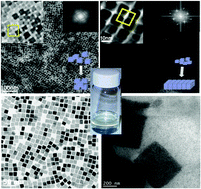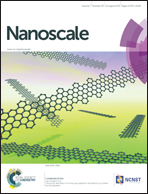Solvothermal synthesis and controlled self-assembly of monodisperse titanium-based perovskite colloidal nanocrystals†
Abstract
The rational design of monodisperse ferroelectric nanocrystals with controlled size and shape and their organization into hierarchical structures has been a critical step for understanding the polar ordering in nanoscale ferroelectrics, as well as the design of nanocrystal-based functional materials which harness the properties of individual nanoparticles and the collective interactions between them. We report here on the synthesis and self-assembly of aggregate-free, single-crystalline titanium-based perovskite nanoparticles with controlled morphology and surface composition by using a simple, easily scalable and highly versatile colloidal route. Single-crystalline, non-aggregated BaTiO3 colloidal nanocrystals, used as a model system, have been prepared under solvothermal conditions at temperatures as low as 180 °C. The shape of the nanocrystals was tuned from spheroidal to cubic upon changing the polarity of the solvent, whereas their size was varied from 16 to 30 nm for spheres and 5 to 78 nm for cubes by changing the concentration of the precursors and the reaction time, respectively. The hydrophobic, oleic acid-passivated nanoparticles exhibit very good solubility in non-polar solvents and can be rendered dispersible in polar solvents by a simple process involving the oxidative cleavage of the double bond upon treating the nanopowders with the Lemieux–von Rudloff reagent. Lattice dynamic analysis indicated that regardless of their size, BaTiO3 nanocrystals present local disorder within the perovskite unit cell, associated with the existence of polar ordering. We also demonstrate for the first time that, in addition to being used for fabricating large area, crack-free, highly uniform films, BaTiO3 nanocubes can serve as building blocks for the design of 2D and 3D mesoscale structures, such as superlattices and superparticles. Interestingly, the type of superlattice structure (simple cubic or face centered cubic) appears to be determined by the type of solvent in which the nanocrystals were dispersed. This approach provides an excellent platform for the synthesis of other titanium-based perovskite colloidal nanocrystals with controlled chemical composition, surface structure and morphology and for their assembly into complex architectures, therefore opening the door for the design of novel mesoscale functional materials/nanocomposites with potential applications in energy conversion, data storage and the biomedical field.


 Please wait while we load your content...
Please wait while we load your content...